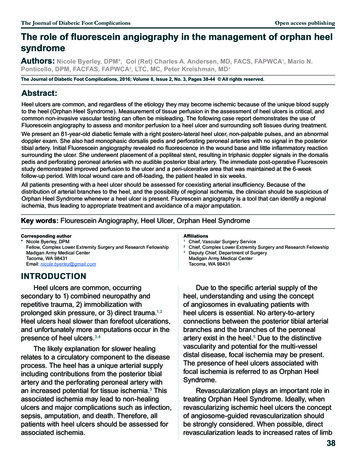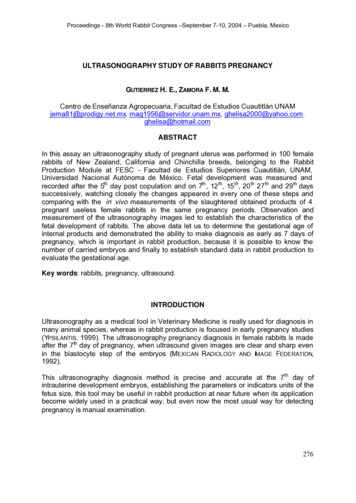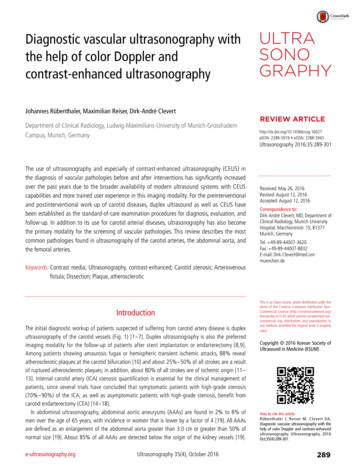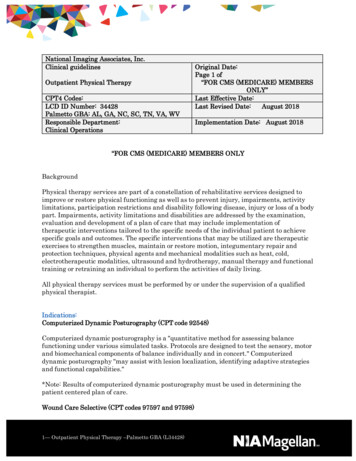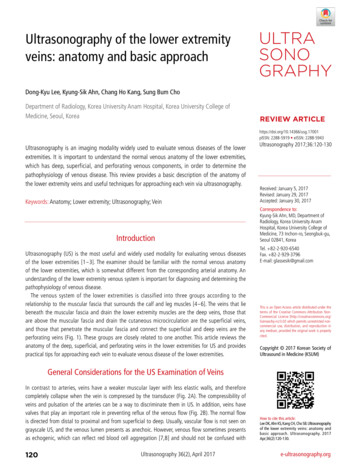
Transcription
Ultrasonography of the lower extremityveins: anatomy and basic approachDong-Kyu Lee, Kyung-Sik Ahn, Chang Ho Kang, Sung Bum ChoDepartment of Radiology, Korea University Anam Hospital, Korea University College ofMedicine, Seoul, KoreaREVIEW ARTICLEhttps://doi.org/10.14366/usg.17001pISSN: 2288-5919 eISSN: 2288-5943Ultrasonography is an imaging modality widely used to evaluate venous diseases of the lowerextremities. It is important to understand the normal venous anatomy of the lower extremities,which has deep, superficial, and perforating venous components, in order to determine thepathophysiology of venous disease. This review provides a basic description of the anatomy ofthe lower extremity veins and useful techniques for approaching each vein via ultrasonography.Keywords: Anatomy; Lower extremity; Ultrasonography; VeinIntroductionUltrasonography (US) is the most useful and widely used modality for evaluating venous diseasesof the lower extremities [1-3]. The examiner should be familiar with the normal venous anatomyof the lower extremities, which is somewhat different from the corresponding arterial anatomy. Anunderstanding of the lower extremity venous system is important for diagnosing and determining thepathophysiology of venous disease.The venous system of the lower extremities is classified into three groups according to therelationship to the muscular fascia that surrounds the calf and leg muscles [4-6]. The veins that liebeneath the muscular fascia and drain the lower extremity muscles are the deep veins, those thatare above the muscular fascia and drain the cutaneous microcirculation are the superficial veins,and those that penetrate the muscular fascia and connect the superficial and deep veins are theperforating veins (Fig. 1). These groups are closely related to one another. This article reviews theanatomy of the deep, superficial, and perforating veins in the lower extremities for US and providespractical tips for approaching each vein to evaluate venous disease of the lower extremities.Ultrasonography 2017;36:120-130Received: January 5, 2017Revised: January 29, 2017Accepted: January 30, 2017Correspondence to:Kyung-Sik Ahn, MD, Department ofRadiology, Korea University AnamHospital, Korea University College ofMedicine, 73 Inchon-ro, Seongbuk-gu,Seoul 02841, KoreaTel. 82-2-920-6540Fax. 82-2-929-3796E-mail: glassesik@gmail.comThis is an Open Access article distributed under theterms of the Creative Commons Attribution NonCommercial License (http://creativecommons.org/licenses/by-nc/3.0/) which permits unrestricted noncommercial use, distribution, and reproduction inany medium, provided the original work is properlycited.Copyright 2017 Korean Society ofUltrasound in Medicine (KSUM)General Considerations for the US Examination of VeinsIn contrast to arteries, veins have a weaker muscular layer with less elastic walls, and thereforecompletely collapse when the vein is compressed by the transducer (Fig. 2A). The compressibility ofveins and pulsation of the arteries can be a way to discriminate them in US. In addition, veins havevalves that play an important role in preventing reflux of the venous flow (Fig. 2B). The normal flowis directed from distal to proximal and from superficial to deep. Usually, vascular flow is not seen ongrayscale US, and the venous lumen presents as anechoic. However, venous flow sometimes presentsas echogenic, which can reflect red blood cell aggregation [7,8] and should not be confused with120Ultrasonography 36(2), April 2017How to cite this article:Lee DK, Ahn KS, Kang CH, Cho SB. Ultrasonographyof the lower extremity veins: anatomy andbasic approach. Ultrasonography. 2017Apr;36(2):120-130.e-ultrasonography.org
Ultrasonography of the lower extremity veinsFig. 1. Normal computed tomography venography of the lower extremities. The venous system of the lower extremities is classified intothree groups: deep veins, which lie beneath the muscular fascia (dotted lines); superficial veins, which are situated above the muscular fascia;and perforating veins, which penetrate the muscular fascia and connect the superficial and deep veins. Note the deep vein (femoral vein,arrows), superficial vein (great saphenous vein, open arrows), and perforating vein (femoral canal perforator, arrowheads) of the thigh.BAFig. 2. Ultrasonographic findings of normal veins.A. In contrast to arteries (open arrows), veins (arrows) have a weaker muscular layer with less elastic walls, and therefore completely collapsewhen compressed by the transducer. B. Veins contain valves that play an important role in preventing venous reflux.thrombosis. This phenomenon is found especially frequently inconditions of slow venous flow. Continuous observation withouttransducer movement or identifying the compressibility of the lumencan be helpful to differentiate this condition from true thrombosis.The selection of a transducer for evaluating the lower extremityveins is a trade-off between resolution and beam penetration.Generally, a frequency of 5 MHz or greater is recommended, butsometimes a lower-frequency transducer is required for deeppenetration views in obese, edematous, or muscular patients [1].e-ultrasonography.orgDeep VeinsAnatomyThe major deep veins of the lower extremities follow the courseof the corresponding arteries. The deep venous system of the calfincludes the anterior tibial, posterior tibial, and peroneal veins.In the calf, these deep veins present as pairs on both sides of theartery. The posterior tibial vein receives blood from the medial andlateral plantar vein and drains the posterior compartment of the legand plantar surface of the foot. This vein lies behind the tibia andUltrasonography 36(2), April 2017121
Dong-Kyu Lee, et al.joins the popliteal vein at the posterior knee. The anterior tibial veinis the upward continuation of the dorsal pedal vein. It runs alongthe anterior compartment of the leg just above the interosseousmembrane between the tibia and the fibula, and joins the posteriortibial vein to form the tibioperoneal trunk and popliteal vein. Theperoneal vein runs along the posteromedial aspect of the fibula andjoins the posterior tibial vein.The popliteal vein is formed by the junction of the anterior andposterior tibial veins at the lower aspect of the posterior knee. Itascends along the posterior aspect of the knee and the distal aspectof the anteromedial thigh. The popliteal vein is located medial tothe artery in the lower knee, superficial to the artery at the posteriorknee, and to the lateral side above the knee.After the popliteal vein goes into the adductor hiatus, it is referredto as the femoral vein. The term superficial femoral vein is no longerrecommended, because this vein is not a superficial vein, but rathera deep vein [9-11]. In the lower part, it lies lateral to the artery; inthe mid-part, behind the artery; and in the upper part, medial to theartery. The deep femoral vein from the inner thigh, running along thedeep femoral artery, joins the femoral vein and forms the commonfemoral vein, which is located medial to the common femoral artery.The inguinal ligament is the landmark that divides the commonfemoral vein from the external iliac vein (Fig. 3).ApproachIt is convenient for the US examination to begin with the patient ina supine or semi-Fowler position. The reverse Trendelenburg position,if possible, is also recommended, as it facilitates venous filling inthe lower extremities and makes the veins dilate. External rotationof the hip and slight flexion of the knee helps to decrease muscletension and is good both for exposing the deep veins in the medialthigh, posterior knee, and calf, and for the compression maneuver(Fig. 4A).Veins drain blood in the distal-to-proximal direction to the rightside of the heart. However, it is convenient to examine the deepveins from a proximal to distal direction because the proximalveins are larger in diameter and easy to detect. At the level of theinguinal ligament, in the transverse view, the examiner can see thecommon femoral vein on the medial side of the artery (Fig. 4B).Information about the flow pattern of the vein can be assessed inthe longitudinal view with Doppler US [12]. Following the commonfemoral vein, it bifurcates into the deep femoral vein and thefemoral vein (Fig. 4C). In the more distal part of the medial thigh,only the femoral vein is visible (Fig. 4D).When the transducer approaches the popliteal fossa of theposterior knee, the popliteal vein is visible. The popliteal vein issuperficial to the popliteal artery at the posterior knee (Fig. 4E).122EIVCFVDFVFVPVPTVATVPevFig. 3. Schematic image of lower extremity deep veins. Althoughlower extremity veins form a continuous structure, they are namedindividually according to their closest anatomic landmark. Theinguinal ligament (upper dotted line) is the anatomic landmarkbetween the external iliac and common femoral veins, and theadductor hiatus (lower dotted line) is the anatomic landmarkbetween the femoral and popliteal veins. EIV, external iliac vein; CFV,common femoral vein; FV, femoral vein; DFV, deep femoral vein; PV,popliteal vein; ATV, anterior tibial vein; PTV, posterior tibial vein; PeV,peroneal vein.Duplicated femoral veins or popliteal veins can be seen [13].Because a duplicated venous segment may result in false-negativeresults, both lumens should be carefully examined (SupplementaryFig. 1). Manual vein compression is recommended every 3-4 cm [3].When tracing the popliteal vein downward, two posteriorlybranching veins are found in the calf from the posteromedialapproach. The vein along the tibia is the posterior tibial vein, andthe vein along the posteromedial aspect of the fibula is the peronealvein. In a US approach, the cortical shadow of the tibia and fibulacan be used as a bony landmark. The paired veins are present onboth sides of the artery (Fig. 4F). After stretching the patient’s leg,the anterior tibial vein can be visualized from an anterolateralapproach (Fig. 5). Just above the echogenic interosseous membranebetween the tibia and the fibula, the anterior tibial artery and veincan be found. If the posterior tibial vein cannot be traced in theproximal to distal direction, it is helpful to trace the vein upwardfrom the posterior to the medial malleolus, where this vein is locatedmore superficially. If the popliteal and calf veins are not visualizedwell in the supine-based position, the prone or decubitus positionUltrasonography 36(2), April 2017e-ultrasonography.org
Ultrasonography of the lower extremity veinsBCDEFFig. 4. Demonstration of side-by-side transverse ultrasonography (noncompression andcompression views) and the corresponding sonic window in computed tomographyvenography based on transducer placement.A. Patient position and schematic representation of the transducer locations are shown here(B, C, D, E, and F). B. The common femoral vein is seen at the level of the inguinal ligament onthe medial side of the common femoral artery, which is round and pulsatile. The vein collapsesupon compression (arrows). C. Upon following the common femoral vein downward, itbifurcates into the deep femoral vein (open arrows) and the femoral vein (arrows).ABCe-ultrasonography.orgUltrasonography 36(2), April 2017123
Dong-Kyu Lee, et al.DFemoral condyleETTFFFD. Only the femoral vein (arrows) is visible in the more distal part of the medial thigh. E. When the transducer approaches the popliteal fossain the posterior knee, the popliteal vein (arrows) becomes visible. F. Tracing the popliteal vein downward from the posteromedial approachshows two posteriorly branching veins in the calf. The vein along the tibia (T) is the posterior tibial vein (arrows) and the vein along the fibula(F) is the peroneal vein (open arrows). The veins are present on both sides of the artery.124Ultrasonography 36(2), April 2017e-ultrasonography.org
Ultrasonography of the lower extremity veinsFig. 5. Ultrasonographic findings of the anterior tibial vein.A. Stretching of the patient’s leg permits approach to the anterior tibial vein from theanterior side. B. Above the interosseous membrane (arrowheads) between the tibia (T)and the fibula (F), the anterior tibial vein (arrows) and artery (open arrows) are visible. Thesonic window is demonstrated through computed tomography venography.ATTFFBcan also be helpful. The distal femoral vein at the level of theadductor hiatus can be difficult to evaluate because of its depth andthe transducer location.Superficial VeinsAnatomyThe two major superficial veins of the lower extremities are thegreat saphenous vein (GSV) and small saphenous vein (SSV). Theterms “greater saphenous vein,” “long saphenous vein,” “lessere-ultrasonography.orgUltrasonography 36(2), April 2017125
Dong-Kyu Lee, et al.ACV of thighPCV of thighAAGSVVein ofGiacominiPAGSVSPJACV of calfSSVPCV of calfGSVABsaphenous vein,” and “short saphenous vein” are no longerrecommended for the purpose of standardizing terminology [10,11].The GSV begins in the medial marginal vein of the dorsum ofthe foot, ascends anteriorly to the medial malleolus, and passesposteromedially to the knee. The vein then ascends medially in thethigh to perforate the muscular fascia and join the common femoralvein at the saphenofemoral junction, a few centimeters distal tothe inguinal ligament. Tributaries of the GSV are variable betweenindividuals, but there are general rules for naming them [10]. If thecourse of the tributary is parallel to the GSV, it is called an accessoryGSV (an anterior accessory GSV or a posterior accessory GSV). Whenthe tributary courses obliquely, it is called the circumflex vein (theposterior thigh circumflex vein or the anterior calf circumflex vein)(Fig. 6A). However, despite attempts to standardize the terminology,various terms have been used and many of the tributaries aredifficult to name.The SSV arises from the dorsal pedal arch and ascendsposterolaterally from behind the lateral malleolus. It ascends alongthe middle of the calf and ends in the popliteal vein in the posteriorknee. However, there are many variations in the termination ofthe SSV, including without connection to the popliteal vein [5,14].Before it penetrates the muscular fascia, it may branch out a cranialextension that goes upward to join the GSV through the posteriorthigh circumflex vein (the vein of Giacomini) (Fig. 6B).126Fig. 6. Schematic images of the superficial veins of thelower extremities.A. The great saphenous vein (GSV) arises from themedial aspect of the dorsal pedal venous arch,ascends anteriorly to the medial malleolus, passesposteromedially to the knee, and ascends medially inthe thigh to join the common femoral vein through thesaphenofemoral junction. Tributaries of the GSV arenamed according to their course. A tributary parallelto the GSV is called an accessory GSV. A tributarythat courses obliquely is called a circumflex vein. ACV,anterior circumflex vein; PCV, posterior circumflex vein;AAGSV, anterior accessory great saphenous vein; PAGSV,posterior accessory great saphenous vein. B. The smallsaphenous vein (SSV) arises from the dorsal pedal archand ascends along the middle of the calf and ends inthe popliteal vein through the saphenopopliteal junction(SPJ). Before it penetrates the muscular fascia, the SSVmay branch out a cranial extension, known as the veinof Giacomini, which goes upward to join the GSV.ApproachInsufficiency of the superficial veins should be evaluated withthe subject in the erect position, as the supine position mayunderestimate or miss the reflux of the venous flow (Fig. 7A). Thereverse Trendelenburg position can be used if an erect positionis impossible. The examined leg should be in a non-weightbearing position [1]. The saphenofemoral junction is visible on theanteromedial surface of the common femoral vein in the transverseview. A longitudinal view of the saphenofemoral junction (Fig. 7B)is useful for assessing reflux of the terminal valve with the help ofDoppler US (Supplementary Fig. 2). Normally, the terminal valve atthe saphenofemoral junction prevents backward flow into the GSV.After a provocation test, such as the Valsalva maneuver, retrogradeflow in the proximal GSV persisting for more than 0.5 seconds isdefined as pathologic reflux [4,15].There is an echogenic fascia surrounding the GSV that is bordereddeeply by the muscular fascia and superficially by the saphenousfascia. This saphenous compartment is readily visualized on USand is described as having an “Egyptian eye” appearance (Fig.7C). The saphenous compartment is also visible at the knee level,above the tibia and medial gastrocnemius (Fig. 7D). Unfortunately,however, there are many variations in the relationship of the fascialcompartment to the GSV. Sometimes there is a large tributaryoutside of the saphenous compartment, while the distal GSV ishypoplastic or even absent [14,16].The SSV is visible at the middle of the gastrocnemius belly inUltrasonography 36(2), April 2017e-ultrasonography.org
Ultrasonography of the lower extremity veinsBCFig. 7. Ultrasonographic findings of the great saphenous vein (GSV).A. Patient position (standing) and schematic representation of the transducer locations areshown here. B. Longitudinal view of the saphenofemoral junction and the corresponding sonicwindow in computed tomography venography based on transducer location are demonstrated.In most cases, a terminal valve (arrows) near the saphenofemoral junction prevents backwardflow into the great saphenous vein. CFV, common femoral vein. C. Examination of the GSVshows the echogenic fascia surrounding the GSV, which is bordered deeply by the muscularfascia (arrows) and superficially by the saphenous fascia (arrowheads). This saphenouscompartment is readily visualized on ultrasonography and is described as having an “Egyptianeye” appearance. D. Transverse ultrasonography examination at the level of the knee shows thesaphenous compartment (arrowheads) overlying the tibia (T) and the muscle fascia of the medialgastrocnemius (G).VCFVGSGSVCFVDBTACDthe fascial trunk (Fig. 8). In tracing the SSV upward, it enters intothe popliteal vein. The longitudinal view of the saphenopoplitealjunction, like the saphenofemoral junction of the GSV, is usefulfor assessing insufficiency of the SSV. In the saphenopoplitealjunction, calf squeezing augments the venous flow at first, followede-ultrasonography.orgGby retrograde flow. As described above, however, there are manyanatomical variations in this region, and the saphenopoplitealjunction may be absent or rudimentary [5,14].Ultrasonography 36(2), April 2017127
Dong-Kyu Lee, et al.Perforating VeinsAnatomyThe perforating veins connect the deep veins with the superficialveins and direct the flow from the superficial to the deep system.There are numerous perforators in the leg. According to a consensusstatement [10], perforators are named after their locations. Majorgroups classify perforators according to their longitudinal locationas ankle, leg, knee, and thigh perforators. Subgroups indicate side(i.e., anterior, posterior, medial, and lateral perforators). Thus, thecomplete name of the perforator is a combination of the level andside (i.e., the medial leg perforator or the anterior thigh perforator).CBGGBAVSSSSVpVPoPop VCFig. 8. Ultrasonographic findings of the small saphenous vein (SSV).A. Patient position and schematic representation of the transducer locations are shown here. B. In the transverse view of the posteriorcalf, the SSV is seen in the middle of the gastrocnemius (G) belly in the fascial trunk (arrowheads). C. Longitudinal ultrasound view andthe corresponding sonic window in computed tomography venography based on transducer location are demonstrated. The SSV joins thepopliteal vein (Pop V) through the saphenopopliteal junction. However, many variations are noted in this region, and the saphenopoplitealjunction can be absent or hypoplastic.128Ultrasonography 36(2), April 2017e-ultrasonography.org
Ultrasonography of the lower extremity veinsMore detailed subgroups are present for medial thigh and medial legperforators. The medial thigh perforators are further classified as theperforating vein of the femoral canal and inguinal perforating vein,and the medial leg perforators are subdivided into the paratibial andposterior tibial perforating veins (Fig. 9). This is convenient becausezit eliminates eponyms such as Hunterian, Dodd, Boyd or Cockett, allInguinal PVPV of thefemoral canalParatibialPVPosteriortibial PVFig. 9. Schematic images of the perforating veins (PVs) along themedial aspect of the lower extremity. The PV of the medial legincludes the paratibial PV and the posterior tibial PV. The medialthigh perforator includes the PV of the femoral canal and theinguinal PV.of which have been used commonly, but are confusing.ApproachNormally, the perforating veins are not clearly visible on US.However, when there is a flow disturbance in the deep or superficialveins or in the case of perforator insufficiency, the perforating veinscan be dilated and are readily visible as a penetrating structurethrough the muscular fascia (Fig. 10A). In the case of varicose veinscaused by perforating vein insufficiency, it is important to localizethe refluxing point in order to correct it.This review describes several clinically relevant perforators aroundthe GSV and their connections. The medial thigh and leg perforatorsare clinically the most important. The medial leg perforatorincludes the posterior tibial perforator and the paratibial perforator.The posterior tibial perforator, previously known as the Cockettperforator, connects the posterior accessory GSV with the posteriortibial vein in the distal calf. The paratibial perforator connects theGSV or its tributaries with the posterior tibial vein. The proximalparatibial perforator was previously called the Boyd perforator. Inthe thigh, the perforating vein of the femoral canal, previously calledthe Hunterian (proximal thigh) or Dodd (distal thigh) perforator,connects the GSV with the femoral vein or the proximal poplitealvein. Insufficiency of these perforators may cause medial thigh andcalf varicosities, even in the absence of saphenofemoral reflux (Fig.10B).ConclusionThe venous system of the lower extremities is divided into threegroups: deep, superficial, and perforating veins. In US examinationGSVPVFVBAFig. 10. Ultrasonographic findings of perforating veins (PVs).A. A dilated paratibial perforating vein in the calf is shown here, which penetrates the muscular fascia (dotted lines). B. A dilated PV of thefemoral canal is shown here, which connects the great saphenous vein (GSV) and the femoral vein (FV). Venous reflux from the deep to thesuperficial vein is seen on transverse and longitudinal views of Doppler hy 36(2), April 2017129
Dong-Kyu Lee, et al.of the lower extremity veins, knowledge of the venous anatomy aswell as appropriate patient positioning and transducer placementare important for optimal imaging and accurate diagnosis.ORCID: Kyung-Sik Ahn: http://orcid.org/0000-0001-9354-5699Conflict of InterestNo potential conflict of interest relevant to this article was reported.Supplementary MaterialSupplementary Fig. 1. Transverse ultrasonography of an 88-yearold man with a pulmonary embolism. The patient shows duplicationof the popliteal vein and thrombosis (arrowheads) in one of thepopliteal lumens. On the compression view, the nonthrombosedlumen shows complete obliteration (arrows), while the thrombosedlumen is not fully compressed (open arrows) (https://doi.org/10.14366/usg.17001).Supplementary Fig. 2. Competent (A) and incompetent (B)saphenofemoral junction. A. After initiation of the Valsalva maneuver,there was no retrograde flow in the proximal great saphenous vein.B. In contrast, retrograde flow that persisted over 3 seconds wasobserved during the Valsalva maneuver, which suggests abnormalfunction of the terminal valve (https://doi.org/10.14366/usg.17001).References1. Guideline developed in collaboration with the American College ofRadiology; Society of Pediatric Radiology; Society of Radiologistsin Ultrasound. AIUM practice guideline for the performance ofperipheral venous ultrasound examinations. J Ultrasound Med2015;34:1-9.2. Coleridge-Smith P, Labropoulos N, Partsch H, Myers K, Nicolaides A,Cavezzi A. Duplex ultrasound investigation of the veins in chronicvenous disease of the lower limbs: UIP consensus document. Part I.Basic principles. Eur J Vasc Endovasc Surg 2006;31:83-92.3. AbuRahma AF, Bandyk D. Noninvasive vascular diagnosis: a130practical guide to therapy. 3rd ed. New York: Springer, 2012.4. Meissner MH. Lower extremity venous anatomy. Semin InterventRadiol 2005;22:147-156.5. Oguzkurt L. Ultrasonographic anatomy of the lower extremitysuperficial veins. Diagn Interv Radiol 2012;18:423-430.6. Cina A, Pedicelli A, Di Stasi C, Porcelli A, Fiorentino A, Cina G, et al.Color-Doppler sonography in chronic venous insufficiency: what theradiologist should know. Curr Probl Diagn Radiol 2005;34:51-62.7. Sigel B, Machi J, Beitler JC, Justin JR, Coelho JC. Variable ultrasoundechogenicity in flowing blood. Science 1982;218:1321-1323.8. Rastegar R, Harnick DJ, Weidemann P, Fuster V, Coller B, BadimonJJ, et al. Spontaneous echo contrast videodensity is flow-relatedand is dependent on the relative concentrations of fibrinogen andred blood cells. J Am Coll Cardiol 2003;41:603-610.9. Bundens WP, Bergan JJ, Halasz NA, Murray J, Drehobl M. Thesuperficial femoral vein: a potentially lethal misnomer. JAMA1995;274:1296-1298.10. Caggiati A, Bergan JJ, Gloviczki P, Jantet G, Wendell-Smith CP,Partsch H, et al. Nomenclature of the veins of the lower limbs: aninternational interdisciplinary consensus statement. J Vasc Surg2002;36:416-422.11. Caggiati A, Bergan JJ, Gloviczki P, Eklof B, Allegra C, Partsch H,et al. Nomenclature of the veins of the lower limb: extensions,refinements, and clinical application. J Vasc Surg 2005;41:719-724.12. Lin EP, Bhatt S, Rubens D, Dogra VS. The importance of monophasicDoppler waveforms in the common femoral vein: a retrospectivestudy. J Ultrasound Med 2007;26:885-891.13. Quinlan DJ, Alikhan R, Gishen P, Sidhu PS. Variations in lowerlimb venous anatomy: implications for US diagnosis of deep veinthrombosis. Radiology 2003;228:443-448.14. Cavezzi A, Labropoulos N, Partsch H, Ricci S, Caggiati A, MyersK, et al. Duplex ultrasound investigation of the veins in chronicvenous disease of the lower limbs: UIP consensus document. PartII. Anatomy. Eur J Vasc Endovasc Surg 2006;31:288-299.15. Min RJ, Khilnani NM, Golia P. Duplex ultrasound evaluation of lowerextremity venous insufficiency. J Vasc Interv Radiol 2003;14:12331241.16. Khilnani NM, Min RJ. Imaging of venous insufficiency. SeminIntervent Radiol 2005;22:178-184.Ultrasonography 36(2), April 2017e-ultrasonography.org
Ultrasound in Medicine (KSUM) How to cite this article: Lee DK, Ahn KS, Kang CH, Cho SB. Ultrasonography of the lower extremity veins: anatomy and basic approach. Ultrasonography. 2017 Apr;36(2):120-130. Introduction Ultrasonography (US) is the most useful and widely used modality for e

